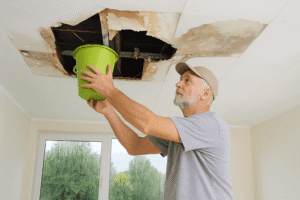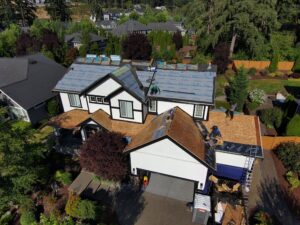Your siding is more than just a visual feature—it’s your home’s first defense against water, wind, and weather. But how do you know when to replace siding instead of just cleaning or painting it?
In this guide, we’ll help you recognize the signs of siding damage, understand the lifespan of different siding materials, and decide whether siding replacement is the right move for your home.
Top Signs It’s Time to Replace Your Siding
Not all siding damage is obvious at first glance. But ignoring early signs can lead to bigger problems. Here’s how to tell when to replace siding is the smart call:
Cracks, Holes, or Warping
If your siding is cracking or warping, it’s time to consider siding replacement. These defects allow water to get behind the panels, which can rot the framing underneath.
Frequent Mold or Mildew
Repeated mold, mildew, or algae stains—especially after cleaning—may be signs of trapped moisture, indicating it’s time to replace siding instead of just cleaning again.
Rising Energy Bills
If your home feels drafty or your energy costs are climbing, your siding may no longer be insulating effectively. In many cases, this is when to replace siding becomes urgent.
Bubbling or Blistering Paint
Paint that bubbles or peels on your siding is a telltale sign of moisture issues and aging materials. It’s one of the clearest indicators for when to replace siding instead of patching.
Cleaning vs Replacing: What’s the Right Move?
It’s easy to assume dirty siding just needs a good scrub. But if your siding still looks worn or damaged after cleaning, it’s time to evaluate when to replace siding seriously.
Cleaning Siding Works Best When:
Dirt and mildew are only on the surface
- Your siding is under 15 years old
- There are no signs of cracking, warping, or rot
- You’re prepping for painting or routine maintenance
- Regular cleaning helps extend your siding’s life—but it won’t reverse age or decay.
Know When to Replace Siding Instead of Cleaning:
- Deep cracks, sagging panels, or wood rot
- Stains that return quickly after washing
- Pest or insect damage behind siding
- Siding is 20–30 years old or more
In these cases, a professional inspection can confirm whether to replace siding now or wait a few more years.
How Long Does Siding Typically Last?
The average siding lifespan depends on the material and climate. Knowing this can help you predict when to replace siding proactively.
- Vinyl siding: 20–30 years
- Wood siding: 15–25 years (with maintenance)
- Fiber cement siding: 30–50 years
- Engineered wood siding: 20–40 years
If your siding is approaching the upper end of its lifespan, it’s smart to schedule an evaluation and prepare for siding replacement within the next few years.
Final Thoughts: When to Replace Siding vs Maintain It
Deciding when to replace siding comes down to the condition, age, and performance of your exterior. While power washing and repainting are short-term solutions, they won’t fix cracked boards, rot, or energy loss.
To protect your home and investment, learn the signs early—and don’t wait too long to replace your siding when the warning signs appear.
Ready to protect your home with new siding?
If you’re noticing signs of wear or wondering when to replace siding, now’s the time to act. Don’t wait for water damage or skyrocketing energy bills—get a professional assessment from a trusted local expert.
📍 Serving homes throughout the Puget Sound region.
💬 Start with a free siding consultation today.


